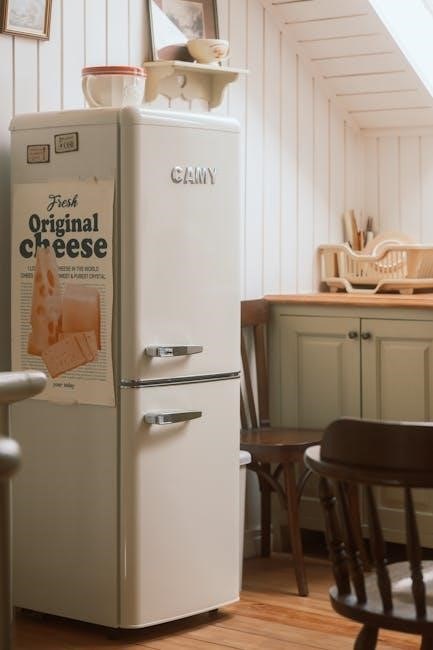
Dometic Refrigerator Operating Instructions
Welcome to the world of Dometic refrigeration! This guide is your gateway to understanding how to safely and effectively operate your new Dometic refrigerator․ It’s crucial to familiarize yourself with these instructions to ensure proper usage‚ longevity‚ and optimal performance․ Keep this manual handy for future reference․
Dometic refrigerators are specifically designed for recreational vehicles‚ offering reliable cooling and freezing capabilities while on the move․ These refrigerators are built to withstand the rigors of travel‚ providing convenience and preserving food freshness during your adventures․ Dometic offers a range of refrigerator models‚ each designed to meet different needs and space requirements․ These include absorption refrigerators that operate on gas‚ AC power‚ or DC power‚ as well as compressor refrigerators‚ which are known for their efficiency and consistent cooling performance․
Understanding the type of Dometic refrigerator you have is the first step in proper operation․ Absorption refrigerators are commonly found in RVs due to their ability to run on multiple power sources‚ while compressor refrigerators are popular for their quick cooling and energy efficiency․ Each type has its own set of operating instructions and maintenance requirements․ This guide will provide general information applicable to most Dometic refrigerators‚ but always refer to your specific model’s manual for detailed instructions and safety precautions․ Proper operation ensures optimal performance and extends the life of your Dometic refrigerator‚ allowing you to enjoy fresh food and cold beverages on all your travels․
Safety Precautions
Before operating your Dometic refrigerator‚ it is crucial to understand and adhere to all safety precautions․ Improper use can lead to potential hazards‚ including gas leaks‚ electrical shocks‚ and fire risks․ Always ensure the refrigerator is installed correctly and in a well-ventilated area; Never obstruct ventilation openings‚ as this can cause overheating and reduce efficiency․

When using gas as a power source‚ ensure the gas supply is properly connected and free from leaks․ Regularly inspect gas lines and connections for any signs of damage or wear․ If you smell gas‚ immediately turn off the gas supply‚ ventilate the area‚ and contact a qualified technician․ When using electricity‚ ensure the refrigerator is properly grounded and connected to a suitable power source․ Avoid using extension cords or adapters‚ as they can overload the electrical circuit․
Never store flammable or explosive materials inside or near the refrigerator․ Keep children away from the refrigerator‚ especially when it is in operation․ Do not attempt to repair the refrigerator yourself‚ as this can be dangerous and void the warranty․ Always consult a qualified technician for any repairs or maintenance․ By following these safety precautions‚ you can ensure the safe and reliable operation of your Dometic refrigerator․
Operating Modes and Settings
Dometic refrigerators offer versatile operating modes to suit your specific needs and power availability․ Understanding these modes and settings is essential for efficient and reliable operation․ Typically‚ Dometic refrigerators can operate on AC power (shore power)‚ DC power (battery)‚ and LP gas․ The selection of the appropriate mode depends on your location and available resources․
When connected to AC power‚ the refrigerator will automatically switch to this mode․ In DC mode‚ the refrigerator draws power from your vehicle’s battery‚ making it ideal for traveling․ However‚ be mindful of battery consumption and avoid prolonged use in DC mode to prevent draining the battery․ LP gas mode is useful when AC power is unavailable and offers an alternative power source․ Always ensure proper ventilation when operating in LP gas mode to prevent carbon monoxide buildup․
Temperature settings can be adjusted using the control panel․ Refer to your refrigerator’s manual for specific instructions on adjusting the temperature․ Generally‚ a lower number indicates a warmer temperature‚ while a higher number indicates a colder temperature․ Experiment with different settings to find the optimal temperature for your needs․ Familiarize yourself with the different operating modes and settings to maximize the performance and efficiency of your Dometic refrigerator․

Manual Ignition (If Applicable)
Some Dometic refrigerator models are equipped with manual ignition for LP gas operation․ This feature is typically found in older models or those designed for off-grid use․ Manual ignition requires you to manually light the LP gas burner to initiate the cooling process․ Before attempting manual ignition‚ ensure that the LP gas supply is turned on and that there are no gas leaks․
To ignite the burner‚ locate the ignition button or lever‚ usually positioned near the burner assembly․ Press and hold the ignition button while simultaneously observing the burner․ You may need to hold the button for several seconds to allow the gas to flow and ignite․ If the burner fails to light after several attempts‚ release the ignition button and wait a few minutes before trying again․ This allows any accumulated gas to dissipate․
Once the burner is lit‚ continue holding the ignition button for a short period to allow the thermocouple to heat up․ The thermocouple is a safety device that detects the presence of a flame and keeps the gas valve open․ If the flame goes out‚ the thermocouple will cool down and automatically shut off the gas supply․ If the burner repeatedly fails to stay lit‚ consult the troubleshooting section of your refrigerator’s manual or contact a qualified technician․
Temperature Control
Maintaining the correct temperature inside your Dometic refrigerator is essential for preserving food quality and preventing spoilage․ Dometic refrigerators offer various methods for temperature control‚ depending on the model․ Some models feature a manual thermostat with a numbered dial‚ while others have electronic controls with a digital display․
For models with a manual thermostat‚ adjusting the dial to a higher number generally results in a colder temperature․ Start with a mid-range setting and allow the refrigerator to operate for several hours before making further adjustments․ Use a refrigerator thermometer to monitor the internal temperature and fine-tune the thermostat accordingly․ The ideal temperature range for a refrigerator is between 34°F and 40°F (1°C and 4°C)․
Electronic temperature controls provide more precise temperature settings․ Use the up and down arrows to select the desired temperature․ Some models also have preset modes for different types of food storage‚ such as “dairy” or “meat․” Keep in mind that ambient temperature and the amount of food stored in the refrigerator can affect its performance․ Adjust the temperature as needed to maintain the proper range․

Troubleshooting Common Issues
Even with proper care‚ you might encounter occasional issues with your Dometic refrigerator․ Before seeking professional help‚ try troubleshooting common problems․

If the refrigerator isn’t cooling‚ check the power supply and ensure the unit is properly connected․ Verify that the thermostat is set correctly and that the cooling unit is functioning․ For gas-powered models‚ confirm that the gas supply is connected and that the burner is lit․ If the refrigerator is running but not cooling efficiently‚ check for obstructions in the ventilation system and ensure the door seals are intact․
Excessive frost buildup can also hinder cooling performance․ Defrost the refrigerator manually or automatically‚ depending on the model․ If the refrigerator is making unusual noises‚ check for loose components or obstructions in the fan․ Consult the user manual for specific troubleshooting steps for your model․ If the problem persists‚ contact a qualified technician․
Cleaning and Maintenance
Regular cleaning and maintenance are essential for prolonging the life of your Dometic refrigerator and ensuring optimal performance․ Before cleaning‚ always disconnect the refrigerator from the power source and remove all food items․
Clean the interior surfaces with a mild soap and water solution‚ avoiding harsh chemicals or abrasive cleaners that could damage the lining․ Pay close attention to cleaning spills and stains promptly to prevent odors and bacterial growth․ Wipe down the door seals regularly to maintain a tight seal and prevent air leaks․ For gas-powered models‚ inspect the burner and flue for debris and clean as needed to ensure proper combustion․
Periodically check the ventilation system for obstructions and clear any blockages to maintain proper airflow․ Defrost the refrigerator regularly to prevent excessive ice buildup‚ which can reduce cooling efficiency․ By following these simple cleaning and maintenance procedures‚ you can keep your Dometic refrigerator running smoothly for years to come․
Finding Your Model’s Manual
Locating the correct manual for your specific Dometic refrigerator model is crucial for accessing detailed information‚ troubleshooting tips‚ and specific operating instructions․ The easiest way to find your manual is by visiting the Dometic website․ Navigate to the support or downloads section and enter your refrigerator’s model number in the search bar․
The model number is typically found on a sticker or plate located inside the refrigerator compartment‚ often near the door or on a side wall․ Once you’ve entered the model number‚ you should be able to download a PDF version of the manual․ If you’re unable to find the manual online‚ you can contact Dometic customer support for assistance․
They may be able to provide you with a digital copy or direct you to a local dealer who can help․ Remember to keep a copy of your manual readily accessible for future reference․
Dometic Refrigerator Parts and Service
When it comes to maintaining your Dometic refrigerator‚ knowing where to find genuine parts and reliable service is essential․ Dometic offers a comprehensive network of authorized service centers and dealers who can assist with repairs‚ maintenance‚ and parts replacement․ To locate a service center near you‚ visit the Dometic website and use the dealer locator tool․
Enter your location to find a list of authorized service providers in your area․ When ordering replacement parts‚ it’s crucial to use genuine Dometic parts to ensure compatibility and optimal performance․ You can purchase parts directly from Dometic or through authorized dealers․
Be sure to have your refrigerator’s model number and serial number handy when ordering parts to ensure you receive the correct items․ Regular maintenance‚ such as cleaning and inspecting components‚ can help prevent costly repairs and extend the life of your refrigerator․ If you encounter any issues that you cannot resolve yourself‚ it’s best to seek professional assistance from a qualified technician․